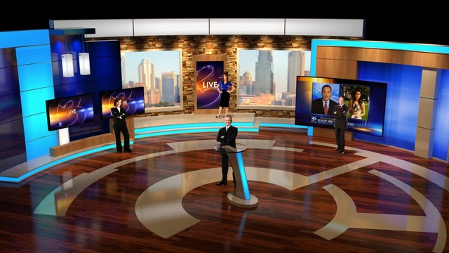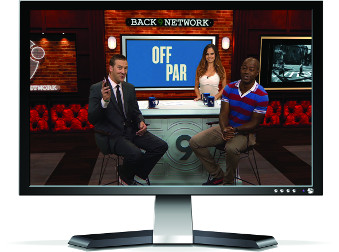Newsrooms Benefiting from Graphic Advances
SAN FRANCISCO—Looking back at those slightly disjointed, jerky productions that popped up in newsrooms more than a decade ago, it’s clear that virtual and augmented reality technology has made strides. Pushed by 3D development in gaming and mobile, and driven by advances in real-time rendering and power capabilities, the evolution of three-dimensional virtual/augmented design is reaching a new peak.
Newsrooms are seeing the benefit. New solutions in the form of virtual sets, augmented reality (AR) technologies and camera-tracking solutions have refined their ability to combine complex 3D graphics into a real studio environment — enabling journalists to convey in-depth concepts and detailed data sets in a clear and compelling new ways.
“With virtual you can afford to do things you couldn’t even afford to do [before]—we’d have to move into a different building to try to do what we’re doing with virtual and in a much smaller space,” said Joseph Maar, vice president of programming and production at the New England Sports Network (NESN), which uses virtual and augmented technology in its newsroom.
SMART INVESTMENT
That was also case for virtual at WBTV-TV in Charlotte, N.C., which adopted new newsroom graphics technology to transform the way it reached out to its Top 25 market audience. The Raycom Media-owned station invested in a newly designed newsroom with a hard set in one studio, and a greenscreen next door, enabling the station to use these sets back to back in a newscast, according to Mack McLaughlin, creative director of FX Design Group, which was involved in the station’s virtual set design. Viewers in Charlotte see a mix of real-world sets and virtual reality elements—a traditional newsroom in one scene, the infield of a baseball field in another.

WBTV-TV in Charlotte, N.C. invested in a newsroom with a hard set in one studio and a green screen next door, enabling the station to interchange between sets back to back in a newscast.
The investment was also smart from a cost-savings perspective, McLaughlin said—far less than the $300,000 it might have cost to invest in a standard hard set. Its appeal when it comes to enticing imagery was immediate. Investment in this kind of technology “doubled the number of shots [they] could do on a given day,” McLaughlin said. The sets can be swapped from a standard newsroom set to a baseball set and used by the station’s sister station KFVS-TV in eastern Missouri.
Get the TV Tech Newsletter
The professional video industry's #1 source for news, trends and product and tech information. Sign up below.
[The technology] explains the story,” he said, whether a station creates a virtualized image of a tank driving into the newsroom set to clarify elements of a war news story, or builds a small swirling virtual tornado spinning around a weatherman to warn viewers of an impending storm. “[Broadcasters] are able to explain the story, walk around the object, bring the story to life,” he said.
THE BENEFIT TO THE VIEWER
The goal of any newsroom set design for a local station is the same: To integrate graphic technology into a newsroom in a way that entices viewers, holds their attention, and tells a story with vibrancy and immediacy.
The key, say newsroom set designers, is to think about the viewer benefit. “For us, the evolving intertwining of scenic and graphics is very exciting,” said Dan Devlin, owner of scenic and lighting design firm Devlin Design Group. “When we think about the ‘viewer benefit’, augmented graphics add another layer of interaction which really draws an audience deeper into the understanding of a story.”
Though stations in the U.S. have been slower to adopt these technologies than their international counterparts, Devlin and others are still seeing ongoing adoption of hybrid solutions that combine both real and virtual options.
Some of the biggest issues when it comes to using virtual technology for newsroom set design is to consider space, technology integration and the reality question.
“In terms of set design, there are few restrictions when considering AR,” said James Eddershaw, managing director for Shotoku UK, which launched a series of manual virtual/augmented reality tracked camera cranes at NAB. Space needs to be incorporated in the design to accommodate the AR objects in a realistic way. “A common method is to create a floor space within the design where floor-based or free-floating graphic objects can be used, and where presenters can closely interact with the objects.”
It’s also important to consider materials used in the set design that can complement the graphics design—think reflections and lighting—to ensure a very natural overall scene.
For full VR greenscreen studios, the quality of the chroma-keying is also paramount. “Even the most advanced graphics and tracking systems will not be convincing if the foreground objects are not cleanly keyed into the VR set,” Eddershaw said. In addition, lighting of the foreground and greenscreen, as well as the virtual lighting effects, plays a huge role in the final composition quality also.
SIGNIFICANT TECHNOLOGY LEAPS
In the earliest years, VR was a fairly major technical undertaking with clear limitations. Harken back to the days when on-air talent attempted to interact in a virtual environment that neither looked realistic or sharply designed. “Presenters could not behave naturally in the studio, creating a forced impression when graphics were inserted,” Eddershaw said, which detracted from the quality of the whole experience.
The technology has taken significant leaps since then. “The use of AR is almost seamless within many studios, avoiding the forced feeling and giving broadcasters and presenters the confidence to use the technology more often and in more natural and interesting ways,” he said.
By using crane technology in a virtualized environment, newsrooms can offer viewers interesting angles. “Being able to ‘fly’ down towards a presenter within an AR environment is a great way to really highlight the power of the 3D graphics,” Eddershaw said. The company’s new Graphica crane solution can also be used on OB sites.
Greater adoption of virtual sets and virtual graphics—particularly for breaking news environments—will most likely be led by improvements in real-time 3D design and integration with knowledge on different 3D virtual set and virtual graphics platforms.

ChyronHego’ CAMIO virtual set and virtual graphics platform.
“Virtual set and virtual graphics are efficient only if the workflow is respected,” said Olivier Cohen, managing director, Hybrid, at ChyronHego, whose virtual set and virtual graphics solution includes CAMIO Universe, which offers robotics motion tracking technology and a 3D graphic engine, Krypton. A number of broadcasters have found success via a template-based approach using an NRCS that can fulfill and create a rundown to playout virtual set and virtual graphics. “This approach allows producers and journalists to quickly create content using virtual graphics and virtual set technology to create a compelling story as it breaks,” Cohen said.
And yet a number of broadcasters still see this technology as a bit of a mystery, particularly in a newsroom setting, citing questions over cost, scalability and the technology’s ease of use.
“They see the technology progressing, but they still find it complex because virtual set and virtual graphics are a multi-discipline technology in the media and entertainment market,” Cohen said. The solution impacts everything from graphics to cameras to vision mixing, he said.
Even so, adoption continues. NESN has installed a mix of virtual and augmented reality technologies to better allow the network to easily swap to a different look or style. “[It can] really advance what we are offering as a network,” Maar said. The network uses a mix of Overdrive, Acuity and XPression technologies from Ross Video along with a virtual set and two robotic cameras.
“The great thing [with this technology] is you can a manipulate that set so that you’re looking in a variety of different ways and different angels,” said Colin Sheehan, operations manager for the Boston-based network.
GIVING BACK CONTROL
NAB 2017 saw new options for the market —particularly those technologies that put graphics control back in the hands of the producer and journalist.
“Our entire design intent is to give control of the newscast back to the newsroom,” said Lan Merrill, vice president with NewsMaker Systems in Moorpark, Calif. Newsmaker Systems’ technology connects MOS-based newsroom systems and invisibly connects that system with a Newtek Tricaster TC1, which opens up functionality of this video production system so steps can be automated via external control. This benefit allows journalists to respond quickly with last-minute graphic additions or rundown changes.
“The two biggest problems that automation systems have with news is that it changes, and it changes really fast,” he said. Clips may need to be flipped out; graphics may need to be slipped in.
Giving journalists more control is also a key tenant of Vizrt;s new Viz Story, a capture, editing and publishing system that allows editors to add 3D graphics to a visual narrative with browser-based tools. Files can be uploaded in the field through the Web-based application, and can be dragged and manipulated into the companion editing system.
And when it comes to graphics in the newsroom, there are a few basic rules that customers should consider when installing tracking and camera technologies and incorporating a graphics into that workflow
“Our advice to customers is simple. If you’re interested in significantly improving the quality of your production while at the same time reducing your production cost, then consider adding robotics to your production platform,” said Rush Beesley, president of RUSHWORKS, whose Locked On Robotic Camera Tracking System and VDX T-Bar Control Surface (within the VDESK and REMO production systems) can be used to automatically track objects in a newsroom and control cameras with shortcut keys.
Susan Ashworth is the former editor of TV Technology. In addition to her work covering the broadcast television industry, she has served as editor of two housing finance magazines and written about topics as varied as education, radio, chess, music and sports. Outside of her life as a writer, she recently served as president of a local nonprofit organization supporting girls in baseball.

